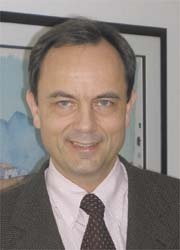New approaches for gentler healing
By Professor Horst Neuhaus MD, Head of Internal Medicine at the Evangelical Hospital, Dusseldorf, describes highlights during April's 33rd Congress of the German Society of Endoscopy and Imaging Procedures (DGE-BV).

Imaging for cancer prevention or early diagnosis
High-resolution video endoscopy as well as endoscopic ultrasound, zoom-endoscopy, tissue colouring and new computer- or magnetic resonance imaging procedures enable early detection of malignant tissue changes. European and Japanese experts presented a critical comparison of the technological expense and clinical benefit of these procedures. One of these new ‘bio-endoscopic’ procedures is fluorescence, used to light up cancerous tissue. Other technologies even promise tissue differentiation in real time, i.e. during endoscopy. With laser-supported technology, even single cells can be seen endoscopically, which means tissue can be more precisely removed and diagnosis often can be carried out during an examination.
Endoscopy for which cancers? Endoscopy is increasingly used for diagnosis, treatment and organ preservation, in pre-cancerous growths and the early stages of cancer, and new techniques of tissue abrasion or destruction have been developed for this. Almost every other stomach cancer is treated in this way in larger Japanese hospitals. German cancer centres lead in the diagnosis and endoscopic treatment of early stage cancer of the oesophagus caused by gastroesophageal reflux. The development of colon cancer can be largely prevented through early colonoscopy and preventive removal of any polyps that may be pre-cancerous growths. Based on conclusive studies, costs for preventive colonoscopy for patients, aged 55+ years, are now born by medical insurers.
Capsule endoscopy - Experts described results and experiences in various European countries. In this exploration, a patient swallows a miniature camera, which transmits excellent images, particularly from the small intestine - previously not accessible for endoscopy. Patients with bleeds from undetermined sources and those with inflammation or tumours of the small intestine particularly benefit from this procedure.
Crohn’s disease - Endoscopy, and other imaging procedures, as well as capsule endoscopy (recent studies) play a very important role in Chrone’s diagnosis. In difficult cases, great progress has been made with a substance called infliximab which blocks an inflammation mediator (TNF-a). New data shows that the success of therapy and further prognosis can be judged reliably through endoscopically determinable healing of previously inflamed mucous membrane.
Reflux - About one in ten Germans suffer frequent heartburn due to gastroesophageal reflux. Less commonly known is that night reflux of acidic stomach contents can lead to laryngitis, hoarseness, chronic coughing and asthma. The cause of these symptoms is often not recognised by doctors. Reflux can be treated with drugs, newly developed endoscopic procedures or laparoscopic surgery - but the choice is not easy and individual patients need interdisciplinary advice. In one in ten of frequent heartburn sufferers, reflux destroys parts of the mucous membrane in the oesophagus, which is then replaced by Barrett’s mucous membrane. ‘Barrett’s oesophagus’ increases the cancer risk.
Video endoscopy, and other complementary therapies, play an important role in diagnosing, monitoring and treating this disease. Reflux case studies were presented in an interactive forum, and a computer-controlled voting system (TED) recorded reactions to controversial issues. Gastroenterologists, surgeons, ENT specialists, etc described recent studies.
Technology and operating theatres - The latest imaging procedures, some only in research laboratories, were presented in a technology symposium. They included miniaturised instruments, navigation or robot supported interventions, textile substances, paramagnetic nanoparticles etc, and microstructures and neurocomputers, with an ability to learn, that function as visual aids for blind patients.
Surgical remote control, via robots and electronically connected instruments (joysticks), now allow a surgeon to sit in a relaxed position as he works via onscreen images transmitted from miniature cameras that are guided to the exact surgical site.
Such technological developments will affect the way we plan the layout of the future operating theatre.
Endoscopic surgical procedures, performed on consenting patients by international experts in their fields, were transmitted live from the Evangelical Hospital Dusseldorf to the Congress Centre Dusseldorf via satellite.
30.04.2003











